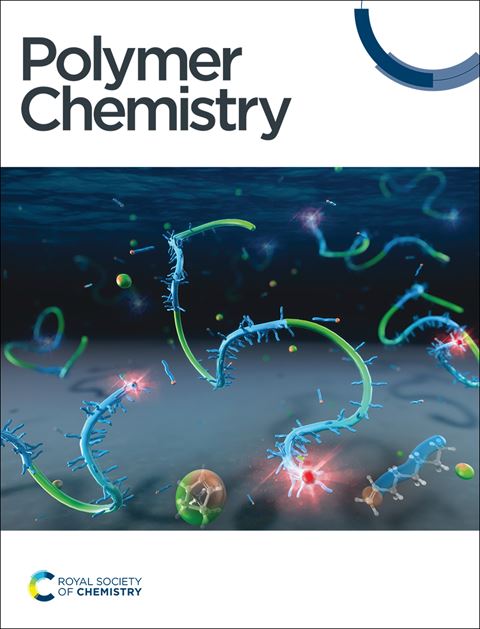Tailoring Tetracationic Linkers to Improve the Physical and CO2 Gas Separation Properties of Doubly Segmented PEEK-Ionene + Ionic Liquid Composites
IF 3.9
2区 化学
Q2 POLYMER SCIENCE
引用次数: 0
Abstract
A series of doubly segmented (DS) poly(ether ether ketone)-ionenes (PEEK-ionenes) was synthesized through polycondensation via Menshutkin reaction, followed by bistriflimide [Tf2N]– anion-exchange. These newly designed tetracationic 2-methylimidazolium (C(2)-Me) linker groups employ a sequence of aromatic (p-xylyl) and aliphatic (hexylene) linkages between cations. The synthesized DS PEEK-ionenes exhibit good solubility in common organic solvents at room temperature, high number average molecular weights ranging from 123 to 159 kDa, and thermal stability up to 410 °C, which are improved compared to counterparts with C(2)-H imidazolium cations. The flexibility of the membranes depends on both the amount of free ionic liquid (IL) added to the PEEK-ionene materials and the characteristic features of the linker groups. The structure-property relationships within the series were established by comprehensively studying the physical properties and gas separation performances. All the newly developed PEEK-ionenes + IL composites have moderate CO2 permeability up to 73 barrer, and the separation performance approaches the 1991 and 2008 upper-bound for O2/N2 and CO2/H2, respectively, and with moderate selectivities for CO2/N2 and CO2/CH4. The elongated charged moieties per segment and introduction of C(2)-Me are key factors for finely tuning and maximizing the separation performance of designed materials.裁剪聚丙烯腈连接剂以改善双节段PEEK-Ionene +离子液体复合材料的物理和CO2气体分离性能
通过Menshutkin反应缩聚合成了一系列双节聚(DS)醚醚酮-离子烯(peek -离子烯),然后进行双striflimide [Tf2N] -阴离子交换。这些新设计的四离子型2-甲基咪唑(C(2)-Me)连接基团在阳离子之间采用一系列芳香(对二甲苯)和脂肪(己烯)键。合成的DS - PEEK-ionenes在室温下具有良好的溶解度,在123 ~ 159 kDa范围内具有较高的数平均分子量,在410℃时具有较高的热稳定性,与C(2)-H咪唑离子相比,具有较高的热稳定性。膜的柔韧性取决于加入到PEEK-ionene材料中的自由离子液体(IL)的量和连接基团的特性。通过对该系列材料的物理性质和气体分离性能的综合研究,建立了该系列材料的结构-性能关系。所有新开发的PEEK-ionenes + IL复合材料具有中等的CO2渗透率,最高可达73阻隔,对O2/N2和CO2/H2的分离性能分别接近1991年和2008年的上限,对CO2/N2和CO2/CH4的选择性中等。每段的延长带电段和C(2)-Me的引入是精细调整和最大化设计材料分离性能的关键因素。
本文章由计算机程序翻译,如有差异,请以英文原文为准。
求助全文
约1分钟内获得全文
求助全文
来源期刊

Polymer Chemistry
POLYMER SCIENCE-
CiteScore
8.60
自引率
8.70%
发文量
535
审稿时长
1.7 months
期刊介绍:
Polymer Chemistry welcomes submissions in all areas of polymer science that have a strong focus on macromolecular chemistry. Manuscripts may cover a broad range of fields, yet no direct application focus is required.
 求助内容:
求助内容: 应助结果提醒方式:
应助结果提醒方式:


